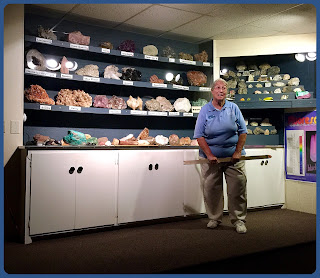Whenever you are in a new place, it's normal to get recommendations on what to see in the area. Well, Rick and I are currently in Iowa attending the 2017 Winnebago GNR Rally (a blog post on that later) and several folks in town (Forest City, Iowa) suggested we visit the "West Bend Grotto". I Googled the place and we set our destination in the car GPS. The actual name of this marvelous shrine is The Grotto of the Redemption and it's in West Bend, Iowa. And I must say - it was worth a look-see.

Of note, there were two others who were instrumental in helping keep Father Dobberstein's dream alive. Matt Szerensce, a parishioner, and Father Louis Greving, Dobberstein's successor, worked side-by-side with Father Dobberstein.

The grotto sits on beautifully manicured grounds that also include a small pond, church, museum, gift shop and lovely gardens.


Let's see...how to describe what I saw. Well, it is a composite of nine separate grottos covering one city block with each grotto portraying a scene in the life of Christ. No matter whether you are a spiritual person, practice a religious faith other than Catholicism or a geologist at heart, this place is worth a stop. It is considered to be the world's most complete man-made collection of gems, fossils, shells and petrified matter. If priced on today's market, the value is well over $4 million US. The price of admission is simply a donation in a box to the upkeep of the grotto at a "suggested" price of $8.00 US per adult and less for a child.

Our docent (volunteer tour guide) was very knowledgeable. We spent approximately 45 minutes being educated as we walked in awe through the maze of the grotto.



The grotto was so ornate in detail that anyone could find something new each time they visited. Everything was set in concrete and all of the materials used in this creation were donated to Father Dobberstein from all over the world. Remembering that almost all of the work was done single handedly by a man weighing no more than 135 pounds makes this place even more startling by its sheer bulk.


This was a depiction of the Garden of Eden made of pieces of sandstone, dolomite, rose quartz, quartz, malachite and chunks of calcium carbonate. Every piece, small and large, was individually placed.





As if the massive architecture wasn't enough to draw your breath away, the lettering on this "plaque" was made of tiny pieces (hand cut) of 23 carat gold (shipped from Venice) laid on mosaic tiles and surrounded by chips of malachite, half shells of abalones, rose quartz, quartz, golden calcite and much more too numerous to list.

The statues were made of hand cut Italian Carrara marble, the same material used by Michelangelo. The one statue of the body of Jesus being laid to rest was carved entirely from ONE piece of Carrara marble. Wow! All statues were carved in Italy then shipped to Father Dobberstein.





A closer view of the attention to detail, especially in the lettering.




Father Dobberstein was particular in finding the right colors in a rock for what he envisioned. His entire plan was never written down nor did he operate from any blueprints. It was all in his head. He created shades and hues by melting crayons with pieces of rock, which was later named Dobberstein Rock.







As I mentioned earlier, there are nine separate grottos.








After walking through the grotto, we were escorted to the rock display studio where our docent talked about the various rocks and gems we saw, including fluorescent rocks.


Adjacent to the grotto was Sts. Peter and Paul Catholic Church where Father Dobberstein was pastor for over 57 years and where he built the Christmas Chapel in 1927.

The faceted stained glass windows in the church tell the theme of Redemption.

A focal point of the sanctuary was the 22-foot bird's eye maple, hand carved altar which won first place at the Chicago World's Fair in 1893. Above the altar was the Ascension mural painted by Father Dobberstein's bother, Bernard, in 1929.

The Christmas Chapel contains mineral specimens too delicate to be used outdoors in the grottos. When you visit, be sure to "press the button" located next to the Chapel and listen to Father Greving's Christmas message explaining the Chapel and what it contains. Also, be sure to look for the Brazilian amethyst in the display that weighs over 300 pounds!

Overall, this was a great way to spend a few hours or a day or more. There are picnic grounds on site and even a campground with 53 RV sites (30 amp only - water and sewer available centrally) and 20 tent sites. For more information, you can visit the grotto website at: West Bend Grotto

No comments:
Post a Comment